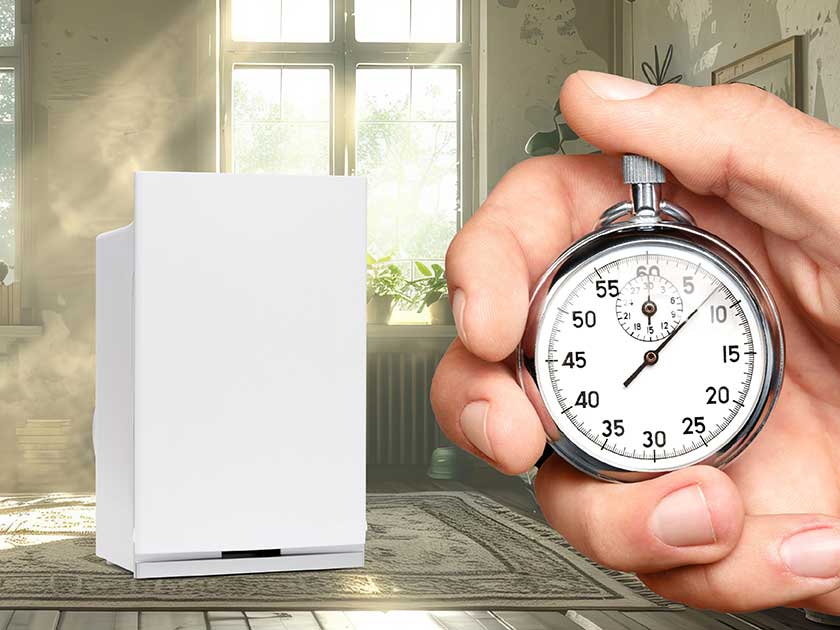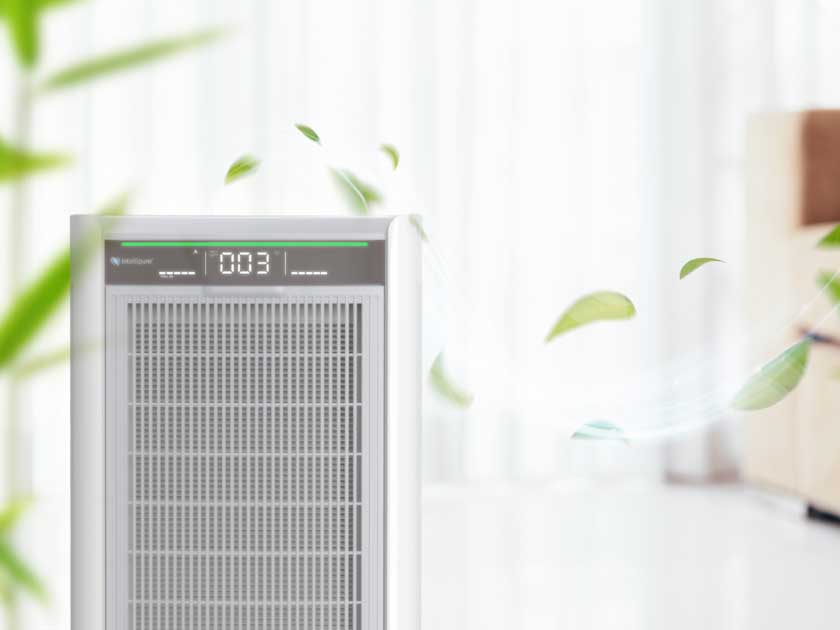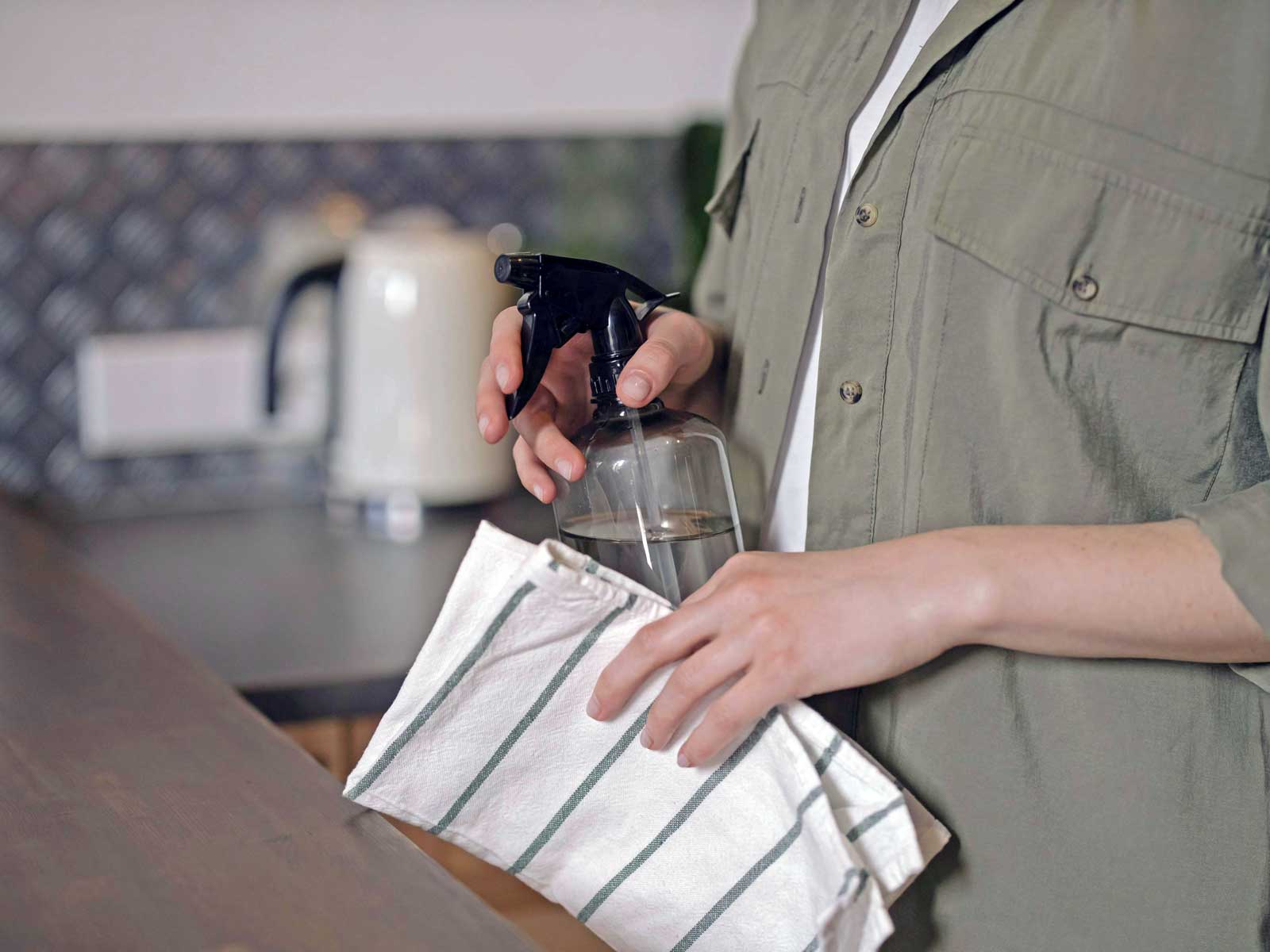
Benefits of Leaving an Air Purifier on 24/7
- Consistent Air Cleaning: Continuous operation ensures your air is always being filtered.
- Health Support: Reduces airborne pollutants that can trigger asthma, allergies, and other health issues.
- Odor & Chemical Control: Constantly removes odors and harmful VOCs from your space.
- Always Prepared: Protects you from unexpected pollutants like wildfire smoke or pollen surges.
- Low Maintenance, High Impact: With auto or sleep modes, modern purifiers like the Intellipure Compact are quiet, efficient, and easy to use.
If you own an air purifier or are thinking of buying one, you may be wondering if you can just leave it on all the time. For most situations running your air purifier 24 hours a day, 7 days a week is the best way to improve your indoor air quality. Here’s why it makes sense to leave your air purifier on all the time.
Benefits of Continuous Air Purifier Operation
Here’s the main benefits to letting your air purifier run all the time.
Constant Air Improvement
The key to consistent air quality is to always be cleaning it. Simply put the more an air purifier runs, the more air it cleans. If you have indoor plants they are already working 24/7 removing carbon dioxide from the air. Letting an air purifier equipped with activated carbon filters run 24/7 gives the same kind of constant air improvement.
Better Health
Clean air has multiple health benefits. People with respiratory issues such as asthma or chronic obstructive pulmonary disease (COPD) can alleviate symptoms by using an air purifier. Air pollution has been linked to more than just lung cancer, but also breast cancer and bladder cancer. Tiny airborne microplastics can enter the lungs and actually cross over into the bloodstream with still unknown long-term results.
Odor Control
Letting your air purifier equipped with activated carbon filters run 24/7 removes nasty odors and harmful chemicals from the air. This is especially important for areas that may be a constant odor source like a trash can or litter box.
Be Prepared
Air quality concerns such as wildfire smoke or pollen don’t always follow a schedule. By having your air purifier up and running before bad outdoor air quality makes its way into your home, you can get ahead of the problem.
Ease of Use
Putting your air purifier on auto mode and just letting it run is about the easiest thing to do. While there is still periodic maintenance that needs to be done (consult your owner’s manual for details), that is a far less frequent task than trying to turn it off and on. Plus if your air purifier has ultra-quiet operation like the Intellipure Compact (only 34 dB on low fan speed) you probably won’t even notice it is running.
Stop Multitasking Your HVAC
While the impact is minor, there may even be a slight increase in your HVAC system energy efficiency. By having the air purifier capture particles instead of your HVAC filter, you don’t need to move to a higher MERV rated HVAC filter to gain better filtration. Most HVAC systems use a MERV 8 filter which is primarily designed to protect the system itself. When HVAC filter replacement time comes around some people try a higher MERV rated filter than the system was designed to use. Using a higher MERV filter can cause extra strain on the fan motor and in some cases impede proper ventilation causing a heating/cooling imbalance.
Best Practices for Usage
Running your air purifier constantly is the best choice for cleaner air. But there are a few things to keep in mind for best results.
Fan Speed Matters
Most air purifiers have multiple fan speed settings. A high-quality air purifier will include information about how much power the fan motor draws along with the associated air flow. For example, the Intellipure Compact only uses 9 watts while moving 22 CFM all the way up to 61 watts to move a massive 150 CFM. If energy conservation is a concern try using a lower fan speed at first. For nighttime purification typically a lower fan speed also means less noise.
Fan speed should also be set high enough to clean all the air in the room at last 4 times per hour. An air purifier is rated by its clean air delivery rate (CADR). The CADR specifies how many cubic feet of air per minute (CFM) an air purifier can clean on its highest fan speed setting. It may be worth adding a few air quality sensors around the house to monitor your real-time indoor air quality so you can adjust your fan speed accordingly.
Keep It Maintained
Your air purifier needs to be maintained based on the manufacturer’s guidelines. It doesn’t matter if you have HEPA filters if they are so clogged no air can pass through them. Follow the manufacturer’s filter replacement schedule or the built-in filter replacement notification if so equipped. Give your air purifier a regular cleaning to keep the air intake grill free from large debris, hair or other gunk.
Follow Your Health
If you or someone else in your home is sick, turning up the air purifier fan speed for maximum air cleaning capacity is a wise idea. A high-quality air purifier can remove airborne microorganisms helping prevent their spread, which is an especially good idea during cold/flu season. During pollen season cranking up the fan speed can fight back against airborne allergens. The same advice works in the winter when dust mite allergies hit full force.

Nighttime Use
There are also health benefits to using an air purifier at night. Removing airborne particles reduces nasal and throat irritation. It also reduces allergens that can cause itchy eyes, running nose, and sneezing that can impact sleep quality. Keep in mind the room size and the air purifier CADR rating to make sure enough air is being cleaned while you sleep. There are tradeoffs between fan speed and noise levels. Bedrooms are typically small rooms, but large rooms may require a faster fan speed or a larger air purifier with a higher CADR that can be run at a lower fan speed. Some air purifiers have an energy saver mode or similar bedtime mode. The Intellipure Compact has a “sleep mode” which dims the LED lights once the desired fan speed is selected.
Potential Drawbacks
While the benefits of continuous air cleaning far outweigh the drawbacks, they do need to be addressed.
Energy Consumption
It takes electricity to operate an air purifier. While most manufacturers keep an eye on energy efficiency, running an air purifier 24/7 still impacts your electricity bill. Your local energy costs may dictate your air purifier operation schedule, and that is okay.
Filter Wear
It is simple: the more you run an air purifier the more pollutants it will capture. This means more frequent filter replacements. Running an air purifier periodically doesn’t avoid maintenance, it just makes the times between filter changes longer. Device features such as maintenance reminders usually operate by machine running time, so the filter change reminder will still work correctly.
Noise
It is hard to move air without making some sort of noise. The slower the fan speed, the less noise, but also the less CFM of air being cleaned. It is a tough balance. Advanced fan designs are able to move air efficiently with less noise, but a completely silent air purifier has yet to be seen. If you are sensitive to noise, running an air purifier while you are away from home may be the best choice.
Safety Concerns
Here are a few safety issues you need to be aware of when using an air purifier.
- Depending on the type of air purification technology, there may be an ozone release during operation. Make sure your air purifier is certified Zero Ozone Emissions from Air Cleaners (UL 2998).
- Never use an extension cord with an air purifier, as there is a fire risk from the extension cord overheating.
- Perform filter replacement regularly. Neglecting filter maintenance can end up putting airborne allergens and pollutants right back into the air if the filter becomes compromised.
Make sure to read the owner’s manual and follow all manufacturer recommendations specified for your air purifier.
Conclusion
You want the best possible indoor air quality, so run your air purifier as often as possible. If noise levels or energy consumption are a concern, use the lowest fan setting. Change the filter regularly so that your air purifier is always operating at peak efficiency. You can also opt for a whole-home air purifier like the Intellipure SuperV. The SuperV is integrated into your existing HVAC system to circulate clean air throughout your entire home. Intellipure's products are carefully engineered so you and your loved ones can enjoy fresher air with every breath.

 Do Air Purifiers Help Control Humidity Levels?
Do Air Purifiers Help Control Humidity Levels?
 How Long for Air Purifier to Work Effectively?
How Long for Air Purifier to Work Effectively?






